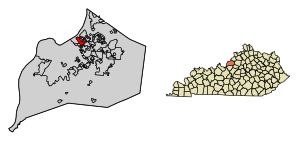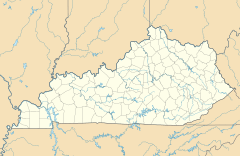Indian Hills, Kentucky facts for kids
Quick facts for kids
Louisville, Kentucky
|
|
|---|---|

Location of Indian Hills in Jefferson County, Kentucky
|
|
| Country | United States |
| State | Kentucky |
| County | Jefferson |
| Incorporated | 1941 |
| Reincorporated | 1999 |
| Named for | a local farm |
| Area | |
| • Total | 1.99 sq mi (5.15 km2) |
| • Land | 1.97 sq mi (5.11 km2) |
| • Water | 0.01 sq mi (0.04 km2) |
| Elevation | 574 ft (175 m) |
| Population
(2020)
|
|
| • Total | 2,860 |
| • Density | 1,448.83/sq mi (559.28/km2) |
| Time zone | UTC-5 (Eastern (EST)) |
| • Summer (DST) | UTC-4 (EDT) |
| ZIP code |
40207
|
| FIPS code | 21-39304 |
| GNIS feature ID | 2404757 |
Indian Hills is a small city in Kentucky, USA. It's located right by the Ohio River in Jefferson County. In 2020, about 2,860 people lived there. Indian Hills is known as one of the richest suburbs of Louisville. Other wealthy towns nearby include Mockingbird Valley, Glenview, and Anchorage. Back in 2000, Indian Hills was even one of the wealthiest places in the entire country!
Contents
Exploring Indian Hills' Location
Indian Hills is in the northeastern part of Jefferson County. It shares borders with several other towns. To the northeast are Glenview and Riverwood. To the east is Northfield. To the southeast, you'll find Windy Hills.
Borders and Roads
To the south, Indian Hills borders Druid Hills and Brownsboro Village. Rolling Fields is to the southwest. The Ohio River forms the northern border, with Indiana on the other side. All other sides of Indian Hills are surrounded by the larger Louisville/Jefferson County government area.
Interstate 71 goes through the northern part of Indian Hills. However, there isn't a direct exit into the city from this highway. U.S. Route 42 marks the southern edge of Indian Hills. This road leads west about 6 miles (10 km) to downtown Louisville.
Land and Water Features
The city covers about 5.1 square kilometers (1.99 sq mi). A small part of this, about 0.05 square kilometers (0.01 sq mi), is water. The Muddy Fork of Beargrass Creek flows through Indian Hills. The area is quite hilly and has many visible rock formations. It's also very densely forested. These hills and forests, along with large property sizes, are what make Indian Hills special.
Green Spaces and Nature
More than a third of the land in Indian Hills is kept undeveloped. Most of this is woodlands. The famous Olmsted Brothers landscaping company designed ten of these natural areas. Other pieces of land have been given to the city over the years. Much of this undeveloped land is along Indian Hills Trail, between the Louisville Country Club and the Ohio River. The Caperton Swamp Nature Preserve is also located within the city.
The undeveloped areas around Beargrass Creek often experience seasonal flooding. This is especially true for areas north of Interstate 71. Sometimes, the intersection of Indian Hills Road and River Road has to close in the spring due to high water.
A Look Back at Indian Hills' Past
The Indian Hill Stock Farm
The city gets its name from the "Indian Hill Stock Farm." This farm belonged to an early settler named John Veech. For a while, it was one of Kentucky's biggest horse farms. Veech owned over 300 acres (120 ha) as early as 1805. His family continued to own most of the land in the area well into the 1900s.
The old Veech house, built in the Georgian-style, is still standing at 125 Indian Hills Trail. The farm's springhouse is at 119 Arrowhead Road. Both buildings are considered important historical sites. An old newspaper article from 1877 said the name "Indian Hill" came from hundreds of Native Americans camped there in 1778. However, naming places after Native Americans was a popular trend in the late 1800s.
How Indian Hills Grew
The Veech family owned much of the land until the 20th century. In 1911, they hired the Olmsted Brothers to design a golf course and a new neighborhood. Two houses from this time are on the National Register of Historic Places. Midlands was built in 1913 for a member of the important Belknap family. Blankenbaker Station, built in 1916, was one of Louisville's first "fireproof" homes.
By 1924, the Louisville Country Club was finished. From 1927 to 1941, the Semonin Company developed the first neighborhood, sometimes called Indian Hills-Country Club. At first, houses had to sell for at least $10,000. This was raised to $20,000 in 1946. The state government officially made Indian Hills a city on December 15, 1941. Calumet Road was the last street from the original plan to be built. Its construction was delayed until the 1950s because the land was so steep.
Challenges with Louisville City
In 1954, Louisville wanted to add Indian Hills to its city limits. This was so they could extend sewer services to the area. But Indian Hills residents strongly opposed this idea. Two years later, Louisville tried again with a bigger plan to add most of its suburbs. Flyers in Indian Hills warned that taxes would go up and city buses would come into their quiet town. Louisville voters approved the plan, but suburban voters rejected it. So, the plan was stopped.
After this vote, Indian Hills started to take more control over its own area. They closed a used car lot and changed the land for homes. They also sued the Louisville Gas & Electric Company. They wanted to remove tall electrical towers. But LG&E won, saying the land was not good for businesses.
In the 1980s, Louisville again suggested adding sewers to Indian Hills. This time, it was without adding the city to Louisville's limits. Indian Hills rejected the plan in 1988. However, building a sewer line through Indian Hills was the only affordable way to get service to towns further east that wanted it. Legal issues delayed construction until 1992. A sewer line was then built through Indian Hills, but it didn't connect to any local houses.
In 1995, a local resident was sued because his septic tank was overflowing. He said it couldn't be fixed without connecting to the city sewer system. The mayor, Jeanne Beam, had been against sewers for 22 years. But she suddenly resigned in June after city leaders decided they would no longer oppose the sewer connection. Starting in 1999, this sewer project became the most expensive in Jefferson County history. It cost residents between $20,800 and $31,200 each.
Also in 1999, Indian Hills became a city again after an election. It joined with the nearby cities of Indian Hills-Cherokee Section (formed in 1955), Robinswood (formed in 1965), and Winding Falls (formed in 1977). This merger made the new city big enough to be a "4th-class" city. This gave it more local control, especially over building rules. This happened before Louisville and Jefferson County joined into one big metro government. The merger also allowed two separate local police departments to combine.
Even with the merger, the Kentucky Secretary of State still lists Indian Hills-Cherokee Section, Robinswood, and Winding Falls as separate cities.
People of Indian Hills
| Historical population | |||
|---|---|---|---|
| Census | Pop. | %± | |
| 1970 | 1,182 | — | |
| 1980 | 2,099 | 77.6% | |
| 1990 | 2,986 | 42.3% | |
| 2000 | 2,882 | −3.5% | |
| 2010 | 2,868 | −0.5% | |
| 2020 | 2,860 | −0.3% | |
| U.S. Decennial Census | |||
| Year | Indian Hills | Indian Hills-Cherokee | Robinswood | Winding Falls |
|---|---|---|---|---|
| 1950 | 291 | n/a | n/a | n/a |
| 1960 | 601 | 226 | n/a | n/a |
| 1970 | 600 | 282 | 300 | n/a |
| 1980 | 787 | 585 | 273 | 454 |
| 1990 | 1074 | 1005 | 250 | 657 |
In 2000, there were 2,882 people living in Indian Hills. These people lived in 1,119 households, with 914 of them being families. The city had about 1,459.5 people per square mile (563.5 per km2). There were 1,162 homes, with about 588.5 homes per square mile (227.2 per km2).
Diversity in Indian Hills
Most of the people in the city were White (95.70%). There were also African American (1.73%) and Asian (1.60%) residents. A very small number were Pacific Islander (0.03%) or from other races (0.03%). About 0.90% of people were from two or more races. Hispanic or Latino people made up 1.46% of the population.
Households and Families
Out of 1,119 households, 32.0% had children under 18 living with them. Most households (76.3%) were married couples living together. Only 3.5% had a female head of household with no husband present. About 18.3% were not families. Also, 16.0% of all households were single individuals. About 8.8% of these were people aged 65 or older living alone. The average household had 2.58 people, and the average family had 2.88 people.
Age Groups
The population was spread out by age. About 23.6% were under 18 years old. About 4.4% were between 18 and 24. The largest group, 36.7%, was between 45 and 64 years old. About 18.1% were 65 years or older. The average age in the city was 47 years. For every 100 females, there were about 96.5 males. For every 100 females aged 18 and over, there were about 93.2 males.
Income and Economy
In 2000, the average income for a household in Indian Hills was $120,602. For families, the average income was $134,600. Men earned more, with an average income of $98,469. Women had an average income of $41,000. The per capita income for the city was $66,637. Very few people lived below the poverty line. About 0.5% of families and 1.2% of the total population were considered to be living in poverty. This included 1.0% of those under 18 and no one aged 65 or over.
Famous People from Indian Hills
- Jennifer Lawrence, a well-known actress who has won an Academy Award.
 In Spanish: Indian Hills (Kentucky) para niños
In Spanish: Indian Hills (Kentucky) para niños



